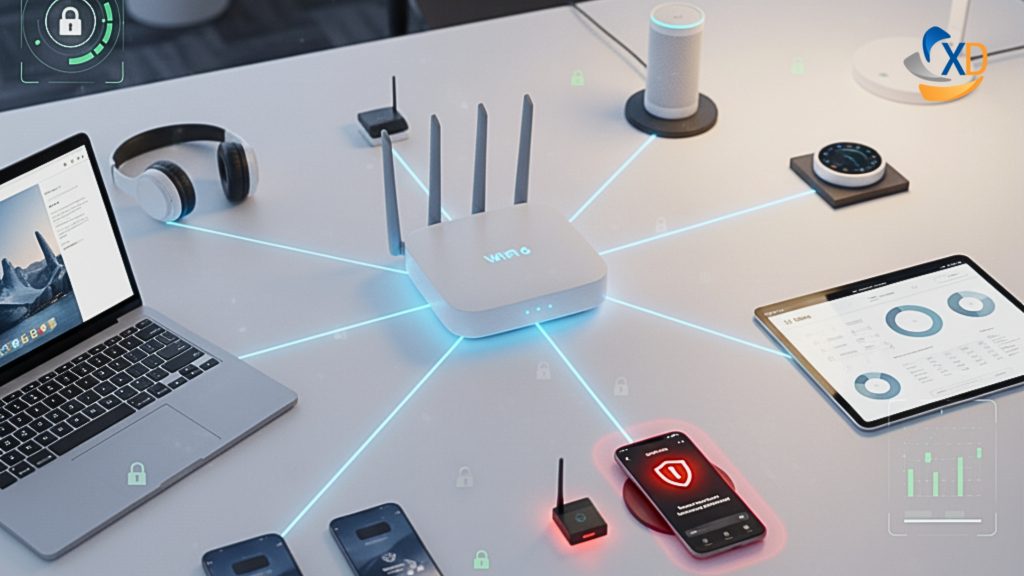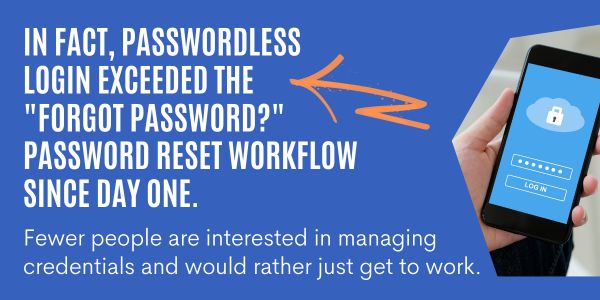Insider Threats: A Growing Cybersecurity Challenge

Insider threats pose a significant risk to organizations of all sizes. These threats come from individuals within an organization who have authorized access to systems and data. They can range from unintentional mistakes to deliberate acts of sabotage.

Types of Insider Threats
- Malicious Acts: Deliberately stealing data, sabotaging systems, or causing damage.
- Negligence: Accidentally compromising security due to carelessness or lack of awareness.
- Espionage: Sharing sensitive information with unauthorized parties.
- Fraud: Using their position to gain financial advantage.

Why Insider Threats Are Dangerous
- Access to Sensitive Data: Insiders have legitimate access to critical systems and data, making them a significant threat.
- Difficult to Detect: Insider threats can often go undetected for extended periods, as they may mimic normal user behavior.
- Damage Potential: Insider threats can cause significant damage, including financial loss, reputational harm, and operational disruption.

How to Mitigate Insider Threats
- Strong Access Controls: Implement robust access controls to limit user privileges and prevent unauthorized access.
- Regular Security Awareness Training: Educate employees about the risks of insider threats and provide them with the tools to identify and report suspicious activity.
- Behavioral Analytics: Monitor user behavior for anomalies that may indicate malicious activity.
- Data Loss Prevention (DLP): Implement DLP solutions to prevent unauthorized data exfiltration.
- Incident Response Plan: Develop a comprehensive incident response plan to address security breaches effectively.
By understanding the risks posed by insider threats and implementing appropriate measures, organizations can significantly reduce their vulnerability to these attacks.
Defending Your Inbox: Combating Today’s Top IT Threats

The digital landscape is a battlefield, and your inbox is the front line. With cyber threats evolving at lightning speed, it’s crucial to equip your business with the right defenses. In this post, we’ll explore the most common IT challenges businesses face in 2024 and how ExchangeDefender can help you stay ahead.
The Modern IT Battleground
Today’s businesses navigate a complex IT environment fraught with challenges. Ransomware, phishing, and data breaches are constant threats, while the shift to remote work introduces new vulnerabilities. Simultaneously, organizations grapple with digital transformation initiatives, talent shortages, and the complexities of managing hybrid workforces.
ExchangeDefender: Your Shield Against Cyberattacks
At the heart of these challenges lies Email Security. As the primary attack vector for many cyber threats, protecting your inbox is paramount. ExchangeDefender offers a comprehensive solution to combat these threats:
- Ransomware Protection: Our advanced threat detection capabilities identify and block malicious emails before they reach your inbox, safeguarding your sensitive data.
- Phishing Defense: Our robust anti-phishing measures educate your employees and protect them from sophisticated phishing attacks.
- Data Loss Prevention (DLP): Prevent sensitive information from leaving your organization through email.
- Email Continuity: Ensure uninterrupted business operations with our email continuity solution, even in the face of email server outages.
Overcoming IT Challenges with ExchangeDefender
Beyond email security, ExchangeDefender can help you address other critical IT challenges:
- Hybrid Work: Our solution supports remote work environments, ensuring secure email access from anywhere.
- Cloud Migration: Seamlessly integrate ExchangeDefender with your cloud infrastructure for comprehensive protection.
- Cost Optimization: Reduce IT expenses by consolidating email security and archiving into a single platform.
By investing in a robust (affordable) email security solution like ExchangeDefender, you can significantly reduce your risk of falling victim to cyberattacks and build a stronger foundation for your business.
Are you ready to fortify your inbox against today’s threats? Message us to learn more about how ExchangeDefender can protect your organization.
#emailsecurity #cybersecurity #ransomware #phishing #datasecurity #exchangedefender
AI Fights Back: 3 Ways Artificial Intelligence Protects You From Cyberattacks

Cybersecurity threats seem to be everywhere these days, from phishing scams in your inbox to malware lurking in the downloads you click. But what if there was a way to fight fire with fire, using artificial intelligence (AI) to outsmart cybercriminals? Believe it or not, AI is becoming a powerful tool in the cybersecurity arsenal. Here are 3 ways AI is working to keep you safe online:
1. Training Champions: Simulating the Bad Guys
Think about a world where cybersecurity professionals could practice their skills against realistic cyberattacks, that look real enough to fool anyone. Well, that world exists thanks to AI! Generative AI can create convincing simulations of cyber threats, allowing security experts to hone their detection and response skills in a safe, controlled environment. The more they practice against these “fake” attacks, the better equipped they’ll be to stop the real ones that come your way.
2. Phishing Emails? No Problem! AI Spots the Fakes
Phishing emails are a classic trick used by cybercriminals to steal your personal information. But AI is making it harder for these emails to slip through the cracks. AI can be trained to identify the subtle clues in a fake email, like unusual phrasing or suspicious sender addresses. By constantly analyzing emails and learning from new phishing attempts, AI helps keep your inbox safe from these deceptive messages.
3. Digital Neighborhood Watch for Unusual Activity
Imagine your computer network as a bustling neighborhood. Normally, things follow a predictable pattern – emails flow in and out, websites are accessed, and data travels along its usual routes. But what if a stranger showed up, acting strangely? AI can monitor your network traffic and learn what “normal” activity looks like. Then, if something unusual happens, like a sudden surge in data or a suspicious connection attempt, AI can raise the alarm. By constantly watching for anomalies, AI helps identify potential cyberattacks before they can cause any damage.
As AI continues to evolve, it will likely play an even greater role in keeping us safe online. So next time you see an article about a cyber threat, remember that there’s a whole team of AI warriors working behind the scenes to keep you protected!
The Challenges of Email Security in a Remote Work Environment: How Encryption Helps

The rise of remote work has transformed the way we operate. While it offers flexibility and convenience, it also introduces new security challenges. One of the biggest concerns is keeping sensitive business communications secure, especially when employees access email from personal devices and unsecured networks.
This is where ExchangeDefender Corporate Email Encryption comes in. It acts as a powerful shield, safeguarding your confidential information even when emails travel outside your company network. Here’s how encryption helps overcome remote work security challenges:
Protection Against Data Breaches
Encrypted emails are rendered unreadable to anyone who doesn’t have the decryption key. This minimizes the risk of data breaches even if a device is lost, stolen, or hacked.
Compliance Made Easy
Many industries have strict data security regulations. Encryption ensures compliance with data privacy laws like HIPAA, GDPR, and PCI DSS, giving you peace of mind.
Secure Communication Across Devices
Employees can access and send encrypted emails from any device, whether it’s a work computer, a laptop at a coffee shop, or even a personal phone. Encryption ensures sensitive information remains secure regardless of location or device.
ExchangeDefender Corporate Email Encryption
offers additional benefits like:
- Easy Integration: The service seamlessly integrates with existing email systems, requiring minimal disruption to your workflow.
- User-Friendly Experience: Both senders and recipients can use encryption easily, without needing extensive technical knowledge.
- Advanced Features: The service offers features like pattern matching and lexicon-based encryption for comprehensive data protection.
By implementing ExchangeDefender Corporate Email Encryption, you can empower your remote workforce to collaborate securely, while safeguarding your business from costly data breaches and ensuring compliance with regulations.
Ready to learn more? Visit ExchangeDefender today to explore how Corporate Email Encryption can take your remote work security to the next level! Link to ExchangeDefender Corporate Email Encryption
Improved SPAM Release Security: Quick Release
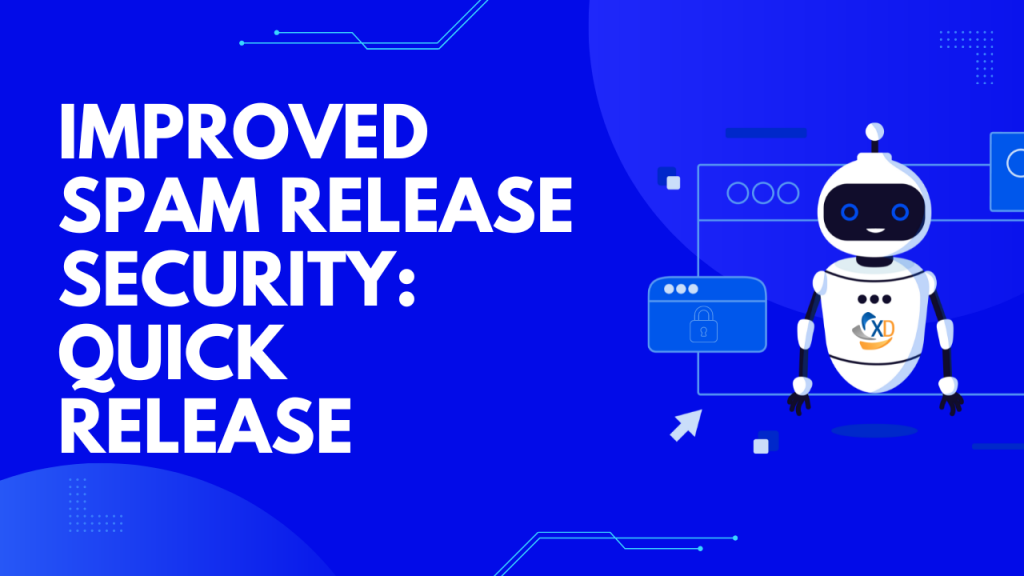
ExchangeDefender is giving users more power to lock down their valuable data. Now that ExchangeDefender handles business continuity and backups for M365/Gmail tenants there is even more information in ExchangeDefender that demands more flexibility with security policies. First, let’s talk about the upcoming feature that allows you to lock down your ExchangeDefender SPAM Quarantine Report activity.
Bit of background: ExchangeDefender Quarantine Reports are an immensely popular ExchangeDefender feature (coming up for an upgrade this spring btw!) that sends users a list of quarantined messages with a set schedule. Users tend to rarely look in Junk Items or review SPAM unless they are waiting for something so this is a cool feature that our users just love. Scroll down the list of quarantined messages and release or trust just by tapping the link. Super convenient, but does it meet your security requirements?

ExchangeDefender Quick Release feature now enables you to choose between convenience and a more secure release process. For many organizations, having the message released or get added to trusted senders with just a click is a huge time saver and user convenience. But if your Microsoft M365 / Gmail account gets compromised (which happens ALL the time) or you deploy a new security/business/CRM (mostly AI stuff) that scans links then this “convenience” can turn into an Inbox packed with SPAM messages that some hacker/service inadvertently released.
If this happens to you, know that ExchangeDefender can help with the “Secure Release” setting. By enforcing Secure Release, when the user clicks to release or trust a message they will be prompted to authenticate before they can release/trust the message. This way if you get hacked or install link scanning/crawling software in your tenant will not be able to access the messages without a password.
Now please, go setup your favorite authenticator app with ExchangeDefender MFA (next up, you can set it to be mandatory/required)
ExchangeDefender Domain Default Security Policy
Has it been a while since you last reviewed your email policies? Do you need to make sure that every user in your organization gets the same protection and the same service behavior and reporting?
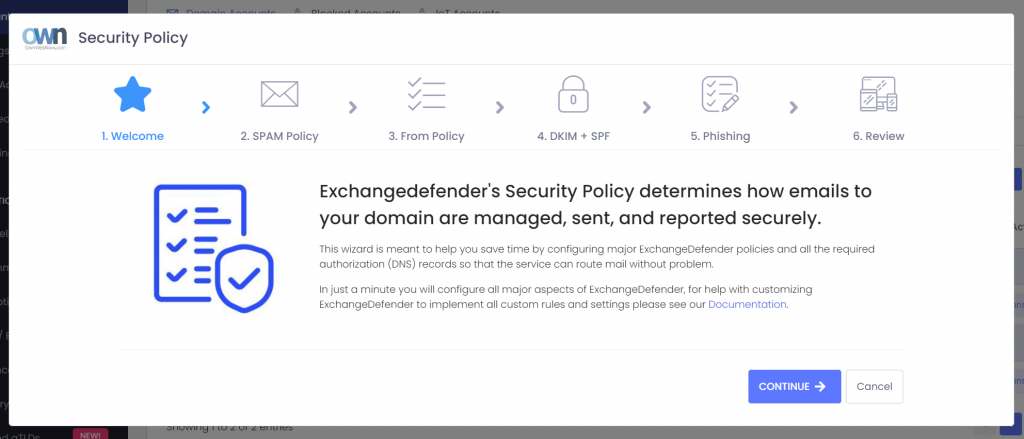
We’ve taken some of our most popular features and wrapped them in a user-friendly wizard that will allow you to quickly configure ExchangeDefender. These settings establish the bare minimum configuration you need to reliably send and receive email on the Internet and instruct ExchageDefender how to sort your email.
Security Policy Overview
Our goal with the Security Policy wizard is to save time while configuring the major aspects of ExchangeDefender. While you still have access to hundreds of policies and can always configure new custom ones (as business requirements demand) it’s nice to know you can quickly adjust the features and make sure they apply to everyone in the organization.
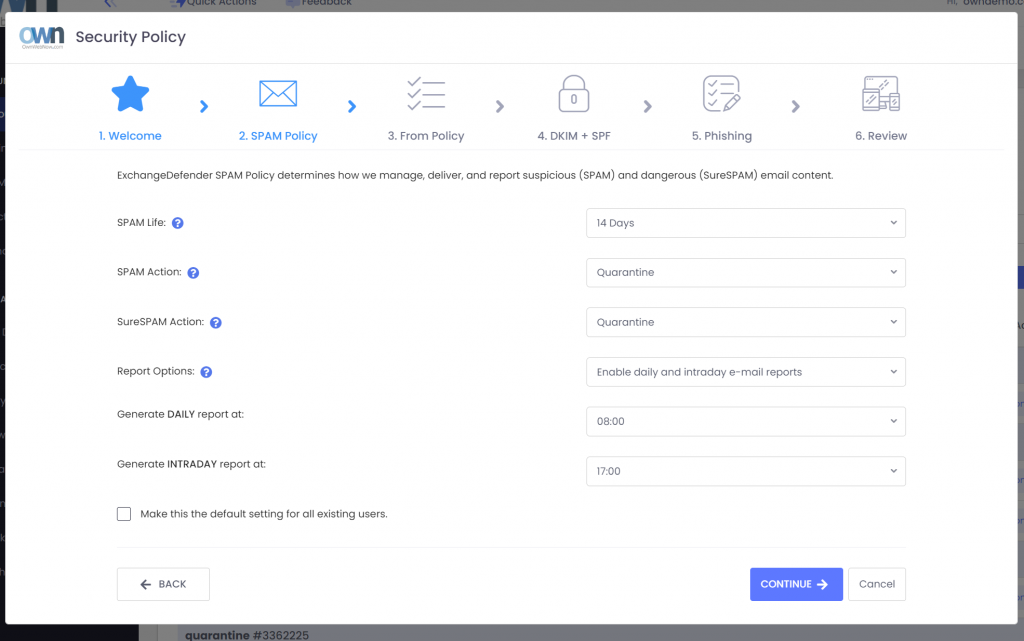
You’ll be able to teach ExchangeDefender how to categorize mail, how long to keep it, and how to report it. Basic SPAM, malware, phishing, and address enforcement policies can be configured in seconds.
We’ve also added some of the settings that are exclusive to ExchangeDefender (From: policy enforcement) and some that always give IT teams trouble (DNS, DKIM + SPF records). The goal was to present all the required and support-intensive features in a friendly way so you can protect your network without knowing the details of the latest standards and security best practices.
Default Security Policy will automatically display the first time you log in as a Domain Administrator. It will load your current settings into the policy and allow you to review it or apply it to all the users in the domain. All the settings are still in their normal places so you can fine-tune your protection and features (https://www.exchangedefender.com/docs >remember the docs).
We hope this new wizard saves you time and gives you peace of mind that your protection is configured correctly.
Passwordless Login – Lower support, better profits
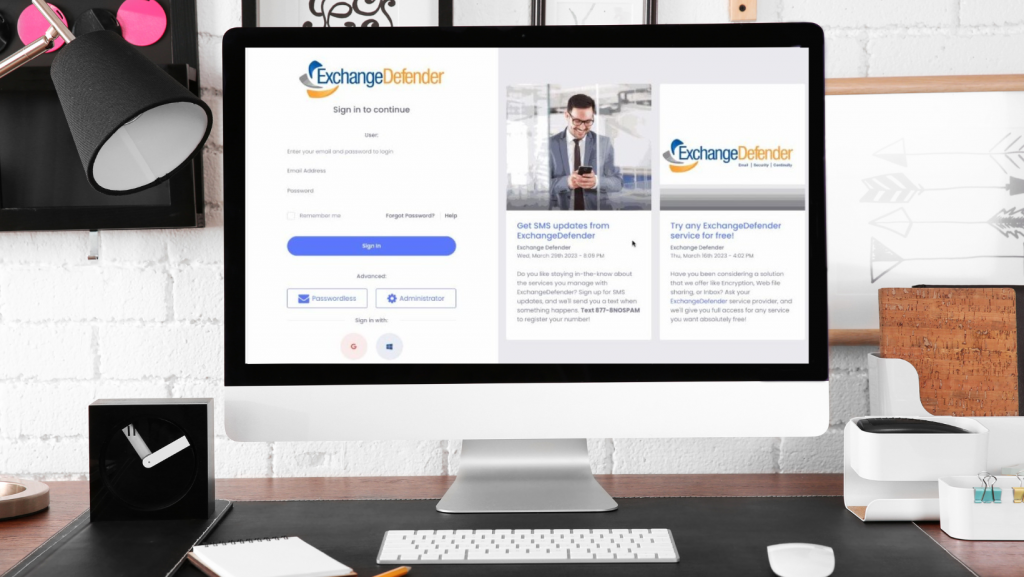
ExchangeDefender Passwordless Login is a new feature that lets users get into their ExchangeDefender account easier and faster. Instead of logging in and tracking passwords, the user just enters their email address and the OTP code we send there – and they get access to all their ExchangeDefender services.
The Passwordless Login feature will drive down the support costs because that was the major issue our clients found in supporting login and authentication problems. We even joked that you may have answered your last login problem email. We now have more data and feedback indicating that this feature is a hit:
In practical terms, wider adoption of this feature means less support work for login and authentication. The fact that it’s more popular than password reset on launch means the users have already seen this feature elsewhere and trust it as a secure way to get into their account.
We’ve also heard from our technical and compliance audience: “It allowed us to finally take you up on an automated password expiration knowing that it will keep our passwords secure and users wouldn’t notice.“
The value we provide to our clients is in the ability to securely email, send secure encrypted messages, and continue emailing when there are IT issues. By making it easier for our users to get to these features everyone benefits.
Thank you for your business and for trusting us to protect your email.
Service Provider Dude, where is my SPAM?

ExchangeDefender is the ultimate cybersecurity wrapper for an organization and we already discussed how Users and Domain Admins can locate messages ExchangeDefender was configured to keep out of the mailbox.
ExchangeDefender users have a beautiful and powerful way to access their quarantined mail and work around email problems, domain admins have flexible settings, policies and access to the logs to keep the organization protected. So what do ExchangeDefender Service Providers have that others don’t?
ExchangeDefender Service Provider access enables you to do deep troubleshooting and emergency “incident response” activities. Service Provider login is the highest level of control in ExchangeDefender so you have access to all the data that ExchangeDefender has.
Accessing Logs
ExchangeDefender Service Provider access gives you access to the centralized log facility where you can locate any message ExchangeDefender has processed from a central pane of glass.
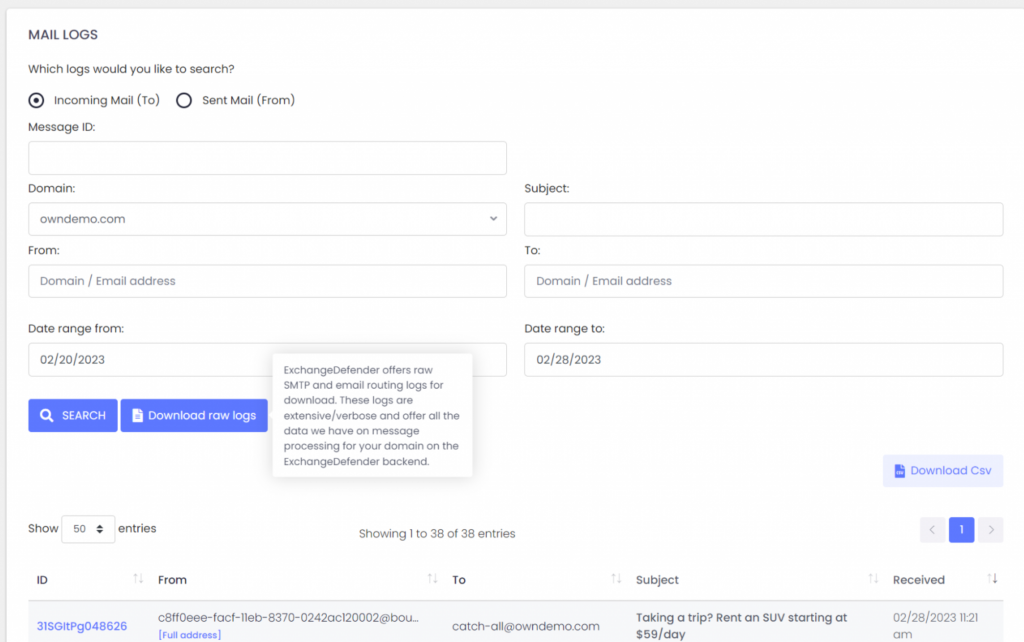
You can download any search results as a CSV file that can be better visualized and analyzed in a spreadsheet and reporting tool of your choice. This is particularly useful when you don’t know the sender or are searching for an automated sender with a fake tracing email address.
Our partners frequently rely on this facility to troubleshoot for missing messages.
Downloading Raw Logs
ExchangeDefender Service Providers also have access to raw SMTP Mail Logs which give our partners direct access to low level SMTP transactions and error logs. It’s located in the same location as log search.
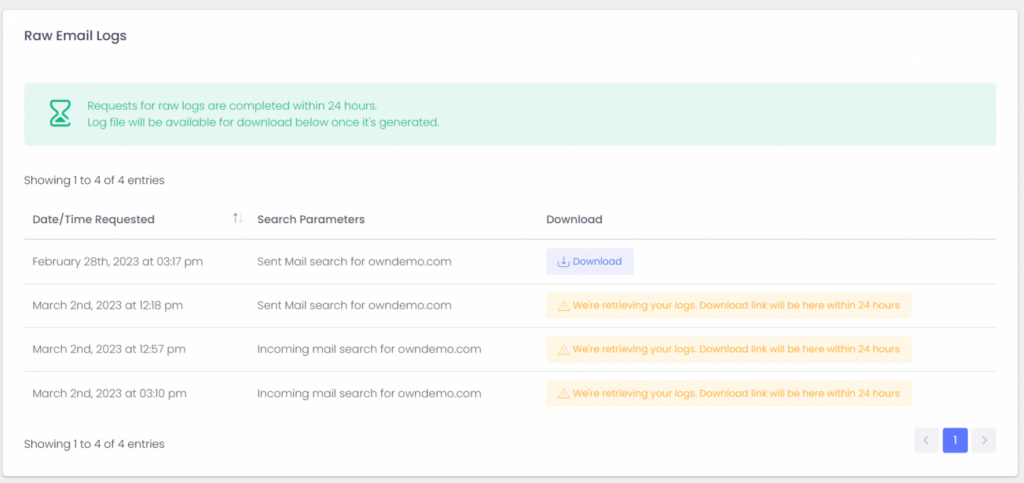
Service Providers rely on these logs as the ultimate source of truth regarding the traffic for the ExchangeDefender protected domain. This is a fantastic tool if you’re looking for intermittent delivery errors or policy violations or just have a very specific email or server you’re looking for.
Logs will get pulled from all our services and will be available for download within 24 hours. Don’t let the boilerplate distract you, almost all of our clients will get their logs within the hour. From there you can load the logs into your favorite analytics tool and dig for the errors and problems in the mail flow.
To sum it up
ExchangeDefender can help you account for every message going in and out of your organization. While users have a powerful and beautiful way to access their quarantined mail or continue where they left off during an outage or email problem, domain admins and service providers have far more access to the logs so they can troubleshoot around different settings and policies.
Introducing ExchangeDefender Inbox
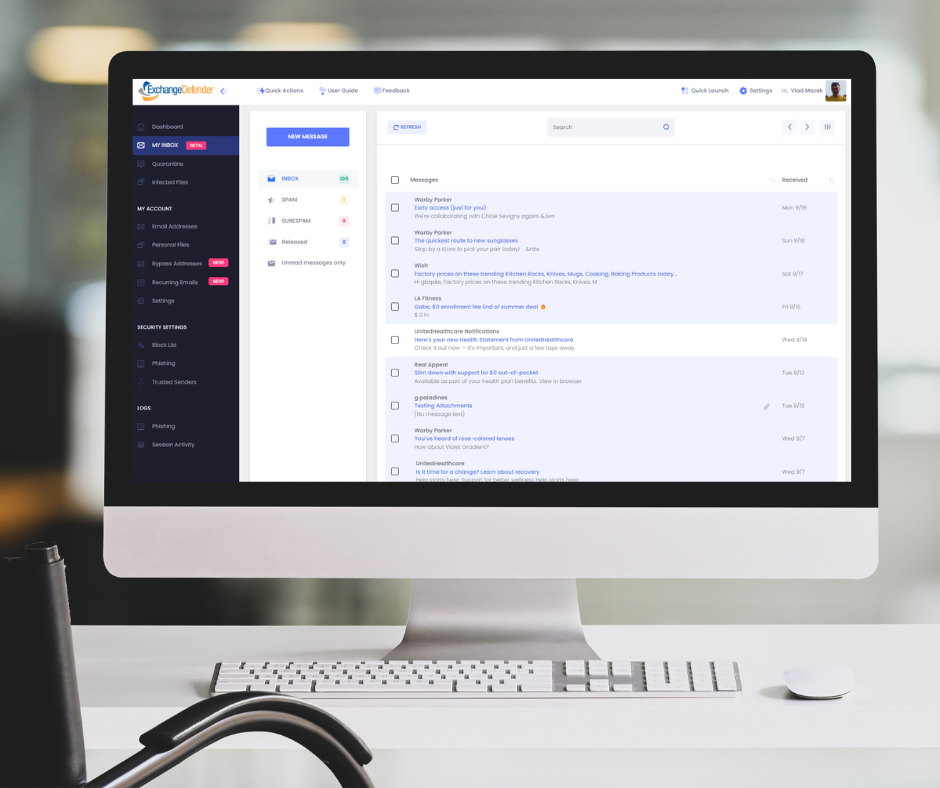
Cybersecurity tops the list of IT concerns and spending, with email still being the most popular service with users and hackers alike: over 90% of compromises start with an email. If that sounds familiar you’ve undoubtedly had to deal with new email authorization standards, user training, troubleshooting mail flow, trying to figure out why email to or from certain people is bouncing, reconciling it all with new IT trends, cyber-insurance requirements, marketing. In a nutshell, email security is still a challenge and users just want something that works.
We’ve reimagined what the email security should look like in 2022 and we cannot wait to show it off:
ExchangeDefender Inbox Webinar
Wed, Sep 28, Noon EST
https://attendee.gotowebinar.com/register/1111619875721771023
We hope you can join us for the webinar and see just how we’ve integrated all the ExchangeDefender security and productivity services to give users a single panel of glass to make email work for them even when they have issues with email. Can’t wait till next Wednesday? Shoot us a ticket at support.exchangedefender.com and ask us to enable it for you today!
ExchangeDefender Inbox combines over two decades of email security experience with the modern, mobile-first world of countless email issues. It enables our clients to get things done with email security and work through all the issues without involving IT. Users want a quick and reliable email platform that just works – work around SPAM filters, around SPF/DKIM policies, around bounces – all while leveraging email encryption to protect sensitive data. The service has been enormously popular with our enterprise clients and now we’re bringing it to all ExchangeDefender users – see you next Wednesday!
5 reasons to secure your law firm right now

Hackers are making big money on the legal industry lately, and it seems to only be getting worse. Law firms are vulnerable to cyber attacks due to the nature of their profession. They handle very sensitive information about their clients like: financial records, company secrets, and health information. Cyber-criminals are taking advantage of the fact that the legal sector is slow-moving when it comes to securing their data. If you’re a lawyer, or work for a law firm, here are five major reasons why you should take measures to secure your company right now:
Reason #1: There is a dramatic increase of data breaches
Law firms pose a higher risk for data leaks due to their business nature of storing and sharing sensitive information. Data leaks are the most common result of cyber-attacks. Due to the lack of security used by many law firms, it is easy for hackers to perform data breaches via malware, phishing, and even denial of service.
Reason #2: Phishing scams are most popular
3.4 billion fake emails are sent each day. In 2020, 74% of organizations in the United States experienced a successful phishing attack. It is becoming increasingly difficult to decipher whether an email is a phishing campaign or not due to the growing sophistication in the attacks.
Reason #3: Hacked email accounts is a major problem
There is a hacker attack happening every 39 seconds, and email is the main use of communication for most professional services. Criminals can take over most of your accounts associated with your email once they have gained access.
Reason #4: Lack of security as a priority
Less than half of all law firms in the U.S use some form of encryption software with custom policies to protect their client’s privacy. This means that a lot of your client’s confidential information is just sitting on a laptop or computer unsecured.
Reason #5: Ethical & regulatory obligations are weighing in
To comply with the ABA’s rule 1.6: Confidentiality of Information, lawyers must make a reasonable effort to secure client information. To operate in an ethical manner according to the American Bar Association, lawyers should have security policies in place to ensure the protection of client data.
Bottom line: Cybercriminals love law firms as targets for their cyber attacks. It is crucial for the modern law firm to protect themselves against email-borne threats, and data leaks. ExchangeDefender specializes in law firm data security, compliance, and continuity solutions. The legal industry relies on ExchangeDefender to mitigate risks of cyber and email attacks. We secure your law practice, and protect your clients by eliminating the danger of data breach or ransomware.



